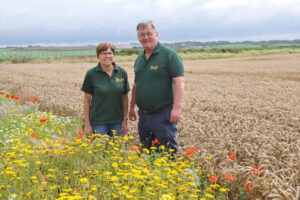 The recipient of the Cereal Grower of the Year award will exhibit a successful rotation strategy and disease management policy. They will consistently achieve high yields and demonstrate a dedication to regenerative agriculture practices. The winning grower will possess a deep understanding of the markets they serve and will have a team of specialised advisors whose expertise is effectively utilised. Sponsored by Limagrain.
The recipient of the Cereal Grower of the Year award will exhibit a successful rotation strategy and disease management policy. They will consistently achieve high yields and demonstrate a dedication to regenerative agriculture practices. The winning grower will possess a deep understanding of the markets they serve and will have a team of specialised advisors whose expertise is effectively utilised. Sponsored by Limagrain.
Richard and Lyn Anthony – R&L Anthony
The Anthonys are proof that crop performance can be maintained while building a sustainable business. The five-year winter wheat yield average is 10.2t/ha for a farm that sequesters about 60,000t of carbon a year.
The environment, soil health and conservation are important to the family, but so too is farming. The system has created habitats and corridors for wildlife that benefit the farm. Allowing beneficials to thrive in combination with changes to the farming system has reduced insecticide and fungicide use, and improved soil health.
A diverse rotation is complemented by novel crops like lupins, cover crops keep soils biologically active and lock in carbon, companion crops cut pest pressure, and livestock manures boost soil moisture retention and resilience.
It’s now a diverse business including a contracting arm and holiday rentals, unrecognisable from the 45ha tenanted business of 20 years ago. Over that time, everything has been researched, tested and evaluated. They have worked closely with various organisations and individuals. Now the enterprise is an Agrii iFarm, AHDB Monitor Farm and it hosts RL, NIAB and plant breeder trials.

The Anthonys have also invested heavily in renewable energy, including a biomass boiler and a 65kW organic Rankine cycle system to produce power used on-site. Grain stores with on-floor drying have been constructed to use surplus heat. This allows cereal crops to be cut at high moisture, dried using a biomass boiler and marketed throughout the year
With a 10-year average yield of Crusoe milling wheat approaching 11t/ha, you’d be forgiven for believing yield is the driver for Colin. But yield at any cost is not his strategy, illustrated by the fact that it is grown using an average of 218kg N/ha. It represents nitrogen use efficiency above that of many farms and a carbon footprint well below.
Behind his approach was the gradual erosion of farming support. He looked at how he could maintain high-input farming yields without high-input practices. Being an AHDB Monitor Farmer helped, as Colin considers knowledge essential to progressive agriculture.

It soon became apparent that various disease problems stem from inappropriate nitrogen use. By managing nitrogen use efficiency, fungicide and plant growth regulator (PGR) applications can be reduced. Other integrated pest management lessons followed.
A wide rotation and drilling wheat late in October is managing blackgrass and reducing fungicides and PGRs. A T0 is no longer applied and any PGR is added with a nutritional cocktail to load the crop for growth. Non-milling wheats are a blend of varieties to lessen disease risk.
Roots in the ground is the most efficient source of organic matter that microbes thrive on, and tillage is the quickest way of destroying them. Insecticide use is now confined to peas only, and sprays are minimised by using barley yellow dwarf virus-tolerant varieties like SY Buzzard.
Russell McKenzie – DJ Tebbit
An inquisitive mind is no bad thing, believes Russell. Pushing for knowledge helped him make a success of a large arable enterprise, and now he has returned to the family farm. The address has changed, but the philosophy won’t. Proposed changes to farm strategy or crop management are researched and trialled first.

He is in year four of a variety trial overlayed with different cultivation and inputs. This has consisted of picking 10 varieties and mirroring them across cultivated and direct-drilled plots. On top of this, six treatment levels are included: untreated; 100% fungicide; 50% fungicide; 100% plus nutrition, 50% plus nutrition and nutrition only.
Varieties are continually assessed and he always has a new one in the system for replacement. Biostimulant trials have shown benefits over bagged phosphate and potassium.
Trials for this season include experimenting with growing alternate winter and spring wheat to assess performance and long-term stability, a possible alternative to OSR.
The effort put into trialling has paid off. A predominantly no-till system with the use of cover crops and variety selection based on reducing risk has produced impressive results. Yield averages are: winter wheat, 11.15 t/ha; spring wheat, 8.23 t/ha; and spring oats, 7.35 t/ha.
The system has seen soil organic matter levels rise to 7-8%, a build-up of beneficials, minimal use of slug pellets and insecticides and 30% more carbon dioxide capture than neighbouring enterprises. That the approach works isn’t in doubt, but as a further check, he benchmarks performance using the AHDB Farmbench service and performance reviews with Ceres Rural.
 The recipient of the Cereal Grower of the Year award will exhibit a successful rotation strategy and disease management policy. They will consistently achieve high yields and demonstrate a dedication to regenerative agriculture practices. The winning grower will possess a deep understanding of the markets they serve and will have a team of specialised advisors whose expertise is effectively utilised. Sponsored by Limagrain.
The recipient of the Cereal Grower of the Year award will exhibit a successful rotation strategy and disease management policy. They will consistently achieve high yields and demonstrate a dedication to regenerative agriculture practices. The winning grower will possess a deep understanding of the markets they serve and will have a team of specialised advisors whose expertise is effectively utilised. Sponsored by Limagrain.

 He is in year four of a variety trial overlayed with different cultivation and inputs. This has consisted of picking 10 varieties and mirroring them across cultivated and direct-drilled plots. On top of this, six treatment levels are included: untreated; 100% fungicide; 50% fungicide; 100% plus nutrition, 50% plus nutrition and nutrition only.
He is in year four of a variety trial overlayed with different cultivation and inputs. This has consisted of picking 10 varieties and mirroring them across cultivated and direct-drilled plots. On top of this, six treatment levels are included: untreated; 100% fungicide; 50% fungicide; 100% plus nutrition, 50% plus nutrition and nutrition only.


